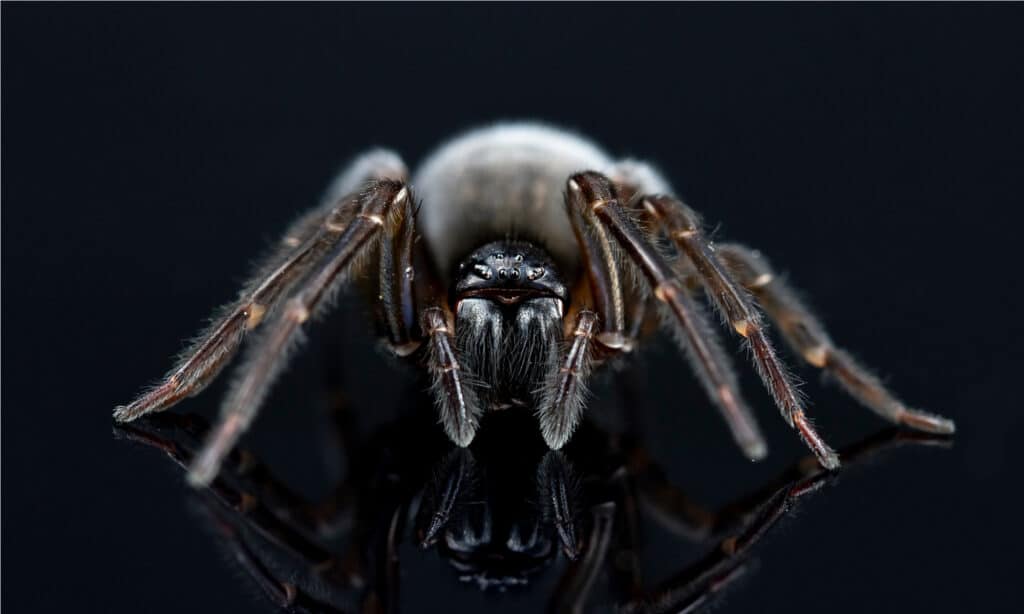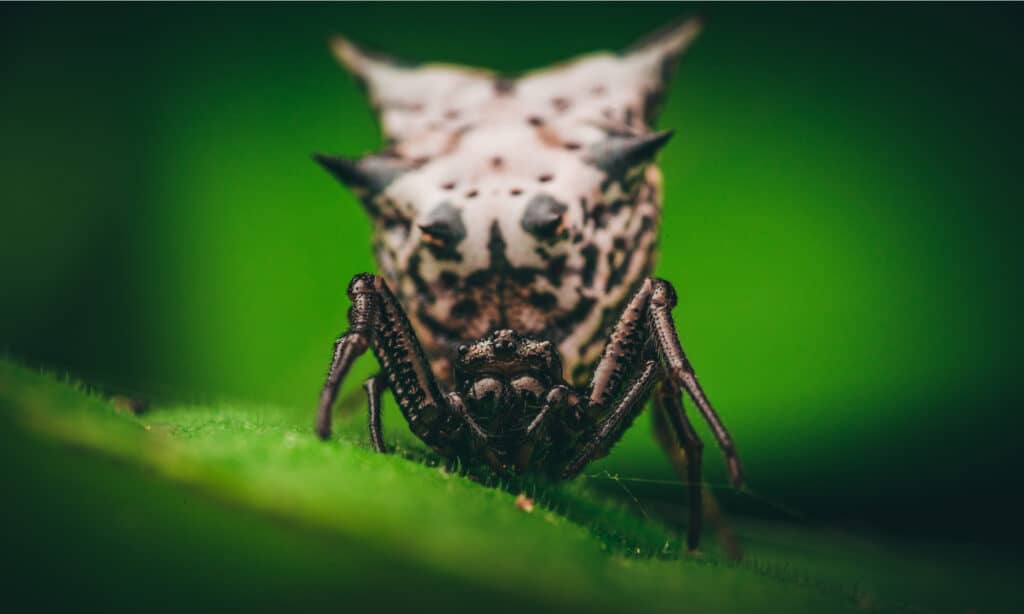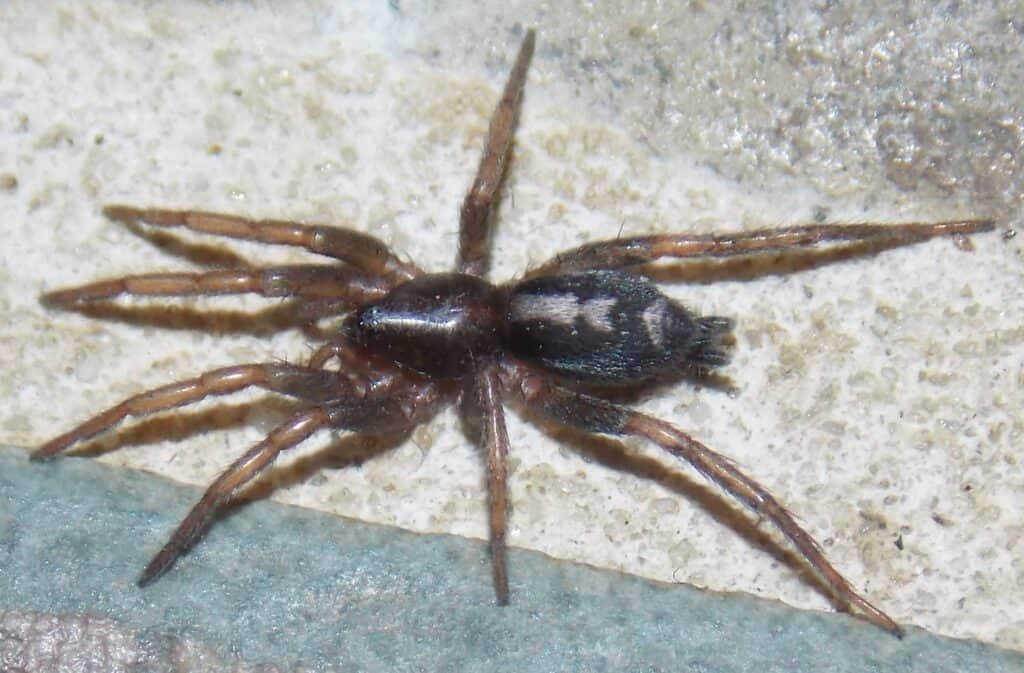Virginia is home to the Blue Ridge Parkway. This gorgeous road takes travelers on a culturally diverse ride from the Central-Southern Appalachian all the way to the neighboring state, North Carolina. It’s also home to a historical landmark, the Virginia Natural Bridge. There’s plenty to enjoy in terms of culture and nature, and it’s also home to a variety of animals. However, in this article, we’ll focus specifically on black spiders living in Virginia.
1. Black Lace-Weaver
Scientific Name: Amaurobius ferox
Black lace-weavers are most often spotted during the month of April in indoor settings. These spiders are black, tan, and brown. They like sheltered environments, and even outdoors, they prefer hiding under debris, rocks, or caves. Although they have different colors, they appear mostly black. These spiders have faint markings on their bellies that have a skull-like appearance. Adult females roam throughout the state nearly any time of the year, but males make their presence known in April when they’re out looking for mates. The mother’s egg sac holds anywhere between 60 and 180 eggs. A not-so-fun but interesting fact about this spider species is that the mother sacrifices herself to provide her spiderlings with sustenance. The name of this phenomenon is matriphagy. These balck spiders living in Virgina can bite humans, but the resulting effect is comparable to the sting of a wasp.

A not-so-fun but interesting fact about black lace-weavers is that the mother sacrifices herself to provide her spiderlings with sustenance.
©IanJHall/Shutterstock.com
2. Spined Micrathena
Scientific Name: Micrathena gracilis
The spined micrathena has several colorations, including black, white, yellow, and red. Most sightings of this spider occur in the later part of July. These spiders have a unique appearance, with a bloated belly with spines. Males are significantly smaller than females and don’t have as many spikes. The males can produce silk, but they reserve their abilities for mating rituals. Spined micrathenas prefer to wander, living nomadic lifestyles with only traces of their webs left behind after they’ve moved. Their preferred environments include forests where they can enjoy hickory and oak trees. Since they like moisture, they typically set up camp near water sources like lagoons and ponds. Although venomous, these black spiders living in Viriginia are harmless to humans.

Spined micrathena spiders have a unique appearance, with a bloated belly with spines.
©Wirestock Creators/Shutterstock.com
3. Eastern Parson Spider
Scientific Name: Herpyllus ecclesiasticus
The eastern parson spider is also known as the “ground spider” or “stealthy ground spider.” Its primary colors include black, brown, gray, and tan. Most sightings of these black spiders in Viriginia occur at the start of the summer season, in May. These spiders move swiftly and are even hard to photograph. Their speed makes them excellent hunters; they don’t require webs to catch their prey. Instead, they use their silk to spin their retreat areas, usually under stones or leaves. They spend time in there resting during the day and use the cover of nightfall to engage in hunting behavior. These spiders are hairy with a white dorsal pattern on their bellies. Their name was chosen because the shape of this pattern resembles a “cravat,” which is a clerical collar that was worn back in the seventeenth and eighteenth centuries. If they are preyed upon, they cleverly run in a zigzag pattern. When fall rolls around, the females use sheltered areas under logs to deposit their egg sacs. This is where they hibernate as well, keeping watch over their sacs.

The shape on
Herpyllus ecclesiasticusspider’s back resembles a “cravat,” which is a clerical collar that was worn back in the seventeenth and eighteenth centuries.
4. Southern Black Widow
Scientific Name: Latrodectus mactans
The southern black widow is also known as the “hourglass spider,” “cobweb spider,” and “shoe button spider.” These venomous spiders can be dangerous to humans (though infrequently deadly). They are usually black with red markings on their bellies, but they may also exhibit other colors, including brown, white, and orange. The marking on their bellies looks like two triangles connecting their points (like an hourglass). If the spider is still young, the top of it may display orange or red spots along with white stripes. The females are significantly larger than the males. They can indeed devour their male counterparts after mating. However, this is only true under exceptional circumstances.

The marking on black widows’ bellies looks like two triangles connecting their points (like an hourglass).
5. False Black Widow
Scientific Name: Steatoda grossa
The false black widow may go by other names, including the “tangle-web spider,” “gumfoot-web spider,” and “false button spider.” Their primary colors include black, brown, tan, white, and even purple. They can usually be spotted at the tail end of winter and the start of spring, in March. These spiders are strikingly similar to black widows, hence their name, but they do not have the distinctive red marking on their bellies. This isn’t the only difference, however. They also have different egg sacs that resemble cotton balls with fluffy white silk. These black spiders living in Virginia are not aggressive, they are even quite shy. During the day, they hide out in crevices and take a more exposed and relaxed posture on their webs overnight.

False black widows are strikingly similar to black widows, hence their name, but they do not have the distinctive red marking on their bellies.
©Dan Olsen/Shutterstock.com
The photo featured at the top of this post is © Porco_Rosso/Shutterstock.com
Thank you for reading! Have some feedback for us? Contact the AZ Animals editorial team.







